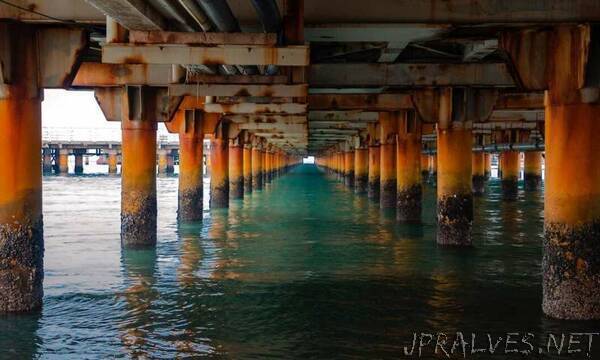
“Rust is a common problem on infrastructure, but new research shows that when it’s combined with salt water, it can also be a source of electricity.
There are many ways to generate electricity—batteries, solar panels, wind turbines, and hydroelectric dams, to name a few examples. …. And now there’s rust.
New research conducted by scientists at Caltech and Northwestern University shows that thin films of rust—iron oxide—can generate electricity when saltwater flows over them. These films represent an entirely new way of generating electricity and could be used to develop new forms of sustainable power production.
Interactions between metal compounds and saltwater often generate electricity, but this is usually the result of a chemical reaction in which one or more compounds are converted to new compounds. Reactions like these are what is at work inside batteries.
In contrast, the phenomenon discovered by Tom Miller, Caltech professor of chemistry, and Franz Geiger, Dow Professor of Chemistry at Northwestern, does not involve chemical reactions, but rather converts the kinetic energy of flowing saltwater into electricity.
The phenomenon, the electrokinetic effect, has been observed before in thin films of graphene—sheets of carbon atoms arranged in a hexagonal lattice—and it is remarkably efficient. The effect is around 30 percent efficient at converting kinetic energy into electricity. For reference, the best solar panels are only about 20 percent efficient.
“A similar effect has been seen in some other materials. You can take a drop of saltwater and drag it across graphene and see some electricity generated,” Miller says.
However, it is difficult to fabricate graphene films and scale them up to usable sizes. The iron oxide films discovered by Miller and Geiger are relatively easy to produce and scalable to larger sizes, Miller says.
“It’s basically just rust on iron, so it’s pretty easy to make in large areas,” Miller says. “This is a more robust implementation of the thing seen in graphene.”
Though rust will form on iron alloys on its own, the team needed to ensure it formed in a consistently thin layer. To do that, they used a process called physical vapor deposition (PVD), which turns normally solid materials, in this case iron, into a vapor that condenses on a desired surface. PVD allowed them to create an iron layer 10 nanometers thick, about 10 thousand times thinner than a human hair. After taking the metal film out of the PVD machine, rust formed spontaneously in air to a thickness of about 2 nanometers.
When they took that rust-coated iron and flowed saltwater solutions of varying concentrations over it, they found that it generated several tens of millivolts and several microamps per cm-2.
“For perspective, plates having an area of 10 square meters each would generate a few kilowatts per hour—enough for a standard US home,” Miller says. “Of course, less demanding applications, including low-power devices in remote locations, are more promising in the near term.”
The mechanism behind the electricity generation is complex, involving ion adsorption and desorption, but it essentially works like this: The ions present in saltwater attract electrons in the iron beneath the layer of rust. As the saltwater flows, so do those ions, and through that attractive force, they drag the electrons in the iron along with them, generating an electrical current.
Miller says this effect could be useful in specific scenarios where there are moving saline solutions, like in the ocean or the human body.
“For example, tidal energy, or things bobbing in the ocean, like buoys, could be used for passive electrical energy conversion,” he says. “You have saltwater flowing in your veins in periodic pulses. That could be used to generate electricity for powering implants.”
The paper describing their findings, titled “Energy Conversion via Metal Nanolayers,” appears in the July 29 issue of the Proceedings of the National Academy of Sciences. Other co-authors include Mavis D. Boamah, Emilie H. Lozier, Paul E. Ohno, and Catherine E. Walker of Northwestern, and Jeongmin Kim, a graduate student in chemistry at Caltech.
Support for the research was provided by the National Science Foundation, the Office of Naval Research, the Defense Advanced Research Projects Agency (DARPA), and the Army Research Chemical Sciences Division.”
